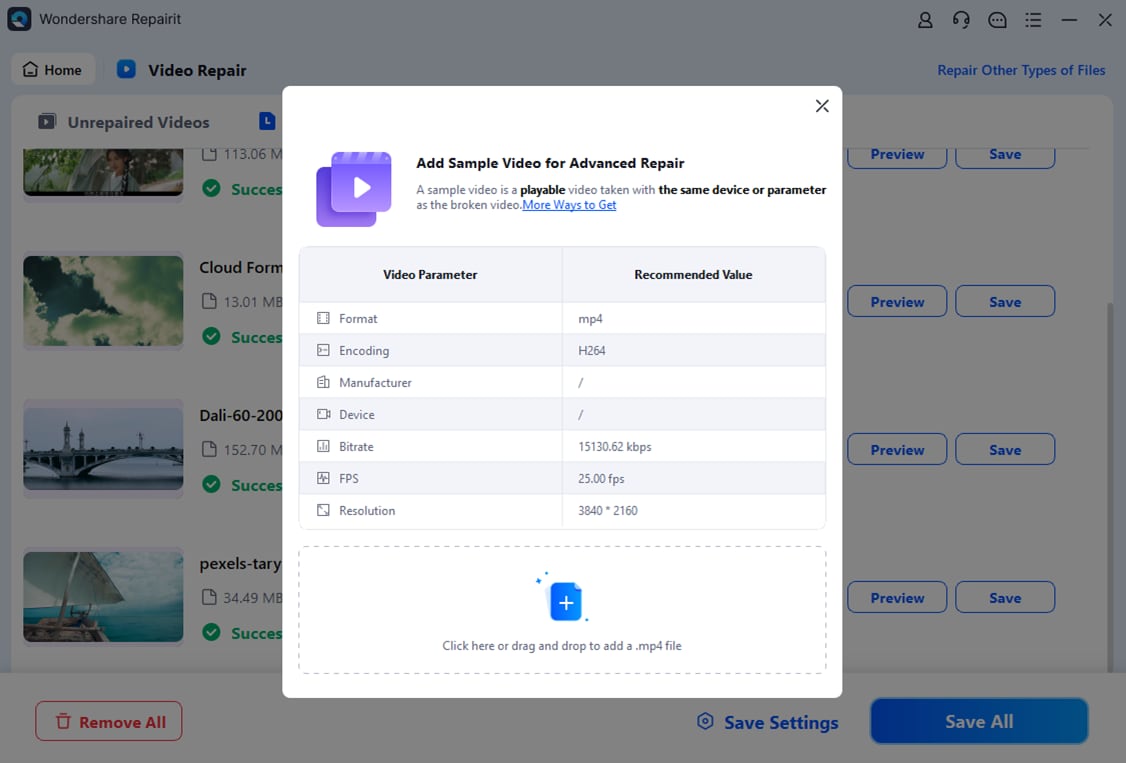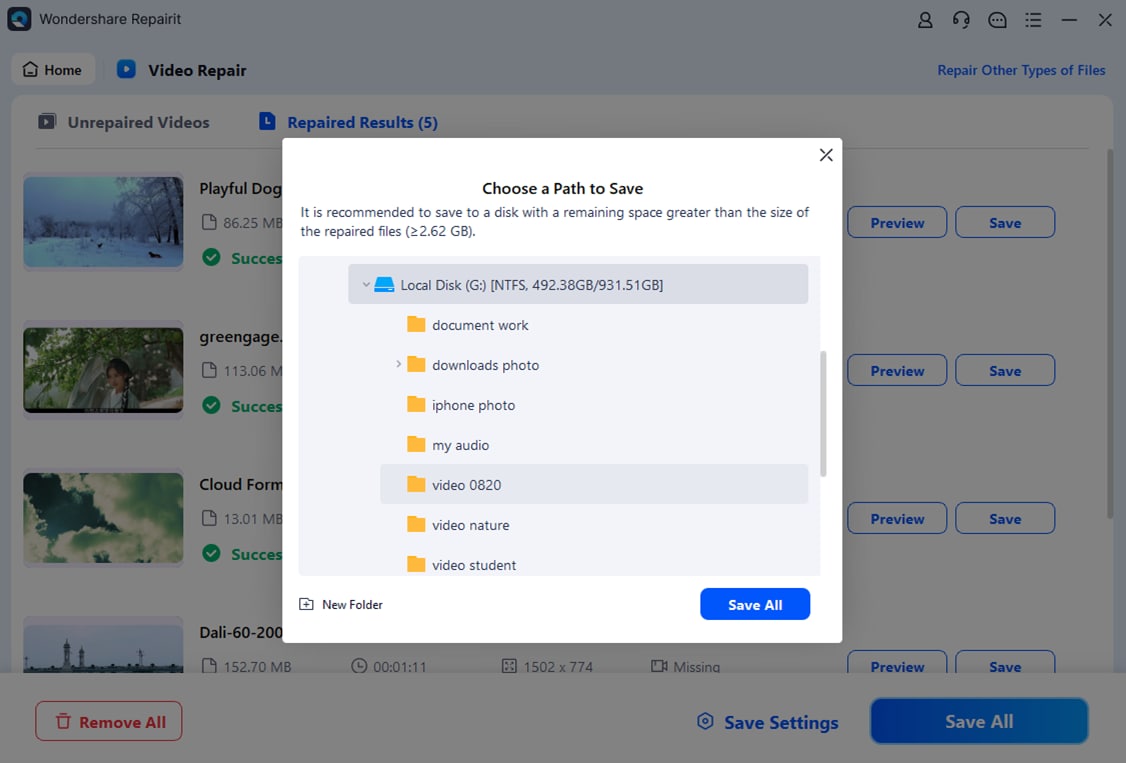Are you deciding between the Canon R7 Mark II and the Canon R6 Mark II? Both cameras have their strengths, and the right choice depends on your needs. Each camera has something unique to offer, wherever you need it for. If you're also thinking about moving into paid event gigs in the future, your decision could impact the types of projects you take on.
This guide will help you understand the key differences and which camera might be the best fit for your photography journey.
Repair ProRes RAW Videos Shot by Canon R7 Mark II

In this article
Part 1: Understanding Canon R7 Mark II & Canon R6 Mark II
Understanding what each camera offers will help one appreciate the whole comparison later on. Canon has created the R7 Mark II and R6 Mark II with unique characteristics separating them. Here we will discuss the advantages and characteristics of both cameras.
Canon R7 Mark II

Reported to have the latest innovations including 6K ProRes RAW recording, the Canon R7 Mark II is an interesting new release. This qualifies it as a strong candidate for videographers seeking high-end video output. It also is expected to contain an APS-C crop sensor. This makes Canon R7 Mark II more fit for sports and wildlife photographers where reach is significant.
Key Features
- Support for 6K ProRes RAW recording, hence improving video project quality.
- APS-C sensor, giving additional reach with telephoto lenses due to the crop factor.
- Fast shooting speeds, likely to appeal to fast-action photography such as sports and wildlife.
Canon R6 Mark II

The Canon R6 Mark II is positioned as an all-rounder with exceptional video and photography capabilities. It offers a full-frame sensor, which enables greater performance in low-light scenarios. And also, it delivers a deeper depth of field. This makes it perfect for portrait and landscape photography. The R6 Mark II features 4K video recording. It is suited for most professional video productions, and improved focusing. This assures sharpness even in fast-moving scenes.
Key Features
- Full-frame sensor, giving improved image quality, especially in low light.
- 4K video recording, more than adequate for most professional needs.
- Excellent autofocus technology, perfect for both stills and video.
- Versatile for portrait, landscape, and event photography. Thanks to the full-frame sensor and ergonomic ergonomics.
Part 2: Canon R7 Mark II vs. Canon R6 Mark II
Now that we’ve introduced both models, let’s look into a side-by-side comparison. This will give you a clear idea of which camera meets your needs better.
| Feature | Canon R7 Mark II | Canon R6 Mark II |
| Resolution & Sensor Size | 33 MP, APS-C sensor (696.4640) | 24 MP, Full-frame sensor (600.4000) |
| ISO Performance | ISO 100–32,000 (expandable to 51,200) | ISO 100–102,400 (expandable to 204,800) |
| Telephoto Advantage | 1.6x crop factor for enhanced telephoto reach | Full-frame, no crop factor |
| Shooting Speed | 15 fps (mechanical), 30 fps (electronic) | 12 fps (mechanical), 40 fps (electronic) |
| Autofocus System | Dual Pixel CMOS AF II, excellent for tracking | Dual Pixel CMOS AF II, superior in low light |
| Video Resolution | Likely supports 6K ProRes RAW recording | 4K video recording, suitable for professionals |
| Video Frame Rates & Codecs | Likely supports ProRes RAW codec, 6K video | 4K at high frame rates |
| Ergonomics | Smaller, lighter, more portable | Sturdy, weather-sealed, robust build |
| Price | ~$1,399.00 USD | ~$1,999.00 USD |
1. Performance and Image Quality

Resolution, Sensor Size, and ISO Performance
The Canon R7 Mark II with APS-C sensor offers a maximum 696.4640 image resolution. While the Canon R6 Mark II has a 24 MP full-frame sensor with a maximum image resolution of 600.4000.. However, the R7’s sensor crop factor is beneficial for telephoto images. This is suitable for wildlife and sports photographers who need that extra zoom. The Canon R6 Mark II, on the other hand, has greater performance in low light due to its larger full-frame sensor, which captures more light.
- Canon R7 Mark II: APS-C sensor, better for telephoto reach, expected solid ISO performance in daylight.
- Canon R6 Mark II: Full-frame sensor, better low-light performance, superior depth of field control.
Autofocus and Shooting Speed
Both cameras excel in autofocus performance, but the Canon R6 Mark II wins out with its improved Dual Pixel CMOS AF technology. This makes R6 significantly faster and more dependable, especially in low light. In terms of shooting speed, the R7 Mark II is projected to be highly competitive. This caters well to fast-action photographers.
- Canon R7 Mark II: Supports up to 15 frames per second (fps) shooting speed using the mechanical shutter and up to 30 fps with the electronic shutter. So, it has likely excellent autofocus for tracking subjects in sports and wildlife.
- Canon R6 Mark II: Slightly superior autofocus, ideal for fast-moving and low-light situations.
2. Video Capabilities

4K vs. 6K ProRes RAW Recording
The Canon R7 Mark II is a game-changer for video professionals that require high resolution for post-production work. This function offers you greater versatility in editing and color grading. The Canon R6 Mark II, despite enabling 4K video, is still an excellent alternative for individuals who don’t want the extra resolution. It needs consistent, high-quality video capture.
- Canon R7 Mark II: 6K ProRes RAW recording for top-tier video projects and detailed post-production work.
- Canon R6 Mark II: 4K video recording. It is great for professional content creation without needing higher resolution.
Frame Rates and Codecs
Both versions offer acceptable frame rate possibilities. But, the R7 Mark II’s speculated ProRes RAW codec is particularly beneficial for high-end video editing. The Canon R6 Mark II’s 4K options are more than suitable for most users. It gives smooth footage at varied frame rates.
- Canon R7 Mark II: Likely to offer ProRes RAW codecs and 6K recording.
- Canon R6 Mark II: Reliable 4K recording at high frame rates.
3. Ergonomics and Build

The R7 Mark II, with its APS-C sensor, is slightly smaller and lighter than the R6 Mark II. This makes it more portable for outdoor shooting, while still keeping Canon’s characteristic ergonomics. The R6 Mark II, with its larger full-frame body, may feel more robust in hand and possibly offer better weather-sealing. It is suitable for pro shooting in varied settings.
- Canon R7 Mark II: More compact and portable, ideal for outdoor and wildlife photographers.
- Canon R6 Mark II: Sturdy and weather-sealed, great for professionals needing durability.
4. Price and Value for Money
The Canon R7 Mark II is likely to be cheaper than the R6 Mark II, partly due to the APS-C sensor. This makes it a perfect choice for individuals on a budget who still want high-end features. The Canon R6 Mark II, with its full-frame sensor and more durable features, comes at a higher price but offers superior performance in return.
- Canon R7 Mark II: $1,399.0.Likely more affordable, better for those prioritizing cost.
- Canon R6 Mark II: $1,999.0.Higher price, but offers more advanced features, especially in low-light performance.
5. Differences in Technology and Features

Sensor Technology and Image Processing
The R7 Mark II’s APS-C sensor means wider reach for telephoto lenses. While the R6 Mark II’s full-frame sensor gives richer image quality and superior performance in different lighting settings.
- Canon R7 Mark II: APS-C sensor, likely excellent for telephoto shooting.
- Canon R6 Mark II: Full-frame sensor, superior image quality and low-light performance.
Video Recording Capabilities
Both cameras offer great video capabilities, with the R7 Mark II standing out due to its anticipated 6K ProRes RAW capability. The R6 Mark II still produces dependable 4K video, making it ideal for most consumers.
Part 3: How to Repair ProRes RAW Videos Shot by Canon R7 Mark II?
ProRes RAW is a high-quality video format. It gives flexibility in post-production for editing and color grading. However, even top-tier video files like ProRes RAW can get corrupted during recording, transport, or editing. This can result in broken or unreadable files. Itnmay create delays in your projects or lead to lost video. Repairing these files is important to avoid re-shoots and to retrieve valuable video information.
Are you a Canon R7 Mark II customer dealing with high-resolution 6K ProRes RAW material? One of the greatest programs for fixing damaged ProRes RAW videos is Repairit Canon Video Repair. This software stands out because of its excellent success rate in restoring ProRes RAW files to their original format. Here are some main reasons to consider using Repairit:
- High Repair Efficiency: Repairit has excelled other repair programs when it comes to mending ProRes encoded files. It effectively fixes videos without changing their original quality.
- ProRes Encoding Restoration: The software supports restoring damaged ProRes files and restores them to the original encoding format, assuring no loss in quality.
- Proven Performance: After thorough testing, Repairit has been found to retain video quality that is 99.47% equivalent to or better than other tools. Additionally, 97.87% of damaged files are successfully restored with proper encoding. This makes Repairit Video Repair highly trustworthy for professionals dealing with ProRes RAW movies
Step 1. Open Repairit. Hit the +Add button to import your ProRes RAW video.

Step 2. Toggle on the Advanced Repair Mode and click Repair.

Step 3. Add a healthy sample video to start repairing your Canon R7 Mark II ProRes RAW video, then click Repair again.

Step 4. Once the process is done, preview your video. If you’re satisfied, click Save.

Repair ProRes RAW Videos Shot by Canon R7 Mark II

Conclusion
Choosing between the Canon R7 Mark II and Canon R6 Mark II depends on your specific photography needs. The Canon R7 Mark II is a great choice for wildlife and sports photographers who need extra reach and fast shooting speeds. While the R6 is perfect for those seeking superior low-light performance, excellent autofocus, and a full-frame sensor for versatile photography. Understanding these differences will help you make the best decision for your journey into mirrorless cameras.
FAQ
-
What type of photographers is the Canon R7 Mark II best suited for?
In addition to being fantastic for wildlife, sports, and action photography, the Canon R7 Mark II's APS-C sensor helps give more reach with lenses. This makes distant objects appear closer. This makes it a great choice for photographers who need to catch fast-moving subjects from far away, such birds or athletes. Its rapid shooting rates allow you to take multiple images quickly. This ensures you don’t miss critical moments in fast-paced scenarios. -
Does the Canon R6 Mark II have better autofocus than the R7 Mark II?
The Canon R6 Mark II’s Dual Pixel CMOS AF system is meant to track subjects more smoothly and accurately. It is particular when illumination conditions aren’t optimal. R6 excels at retaining moving subjects in sharp focus. It is vital for event photography, like weddings or concerts, where lighting can shift. The autofocus technology also works well for video. This makes it easier to focus on subjects without manual modifications. -
Do both Canon R7 Mark II and R6 have weather sealing?
Both cameras are expected to handle harsh outdoor circumstances, such as rain, dust, or snow, thanks to their weather sealing. This makes them reliable for outdoor photographers who routinely shoot in unusual situations. It includes wildlife photographers or those working in trip photography. The durable structure helps guarantee that the cameras continue performing effectively even under challenging situations. It delivers peace of mind during shooting in adverse weather.


 ChatGPT
ChatGPT
 Perplexity
Perplexity
 Google AI Mode
Google AI Mode
 Grok
Grok

